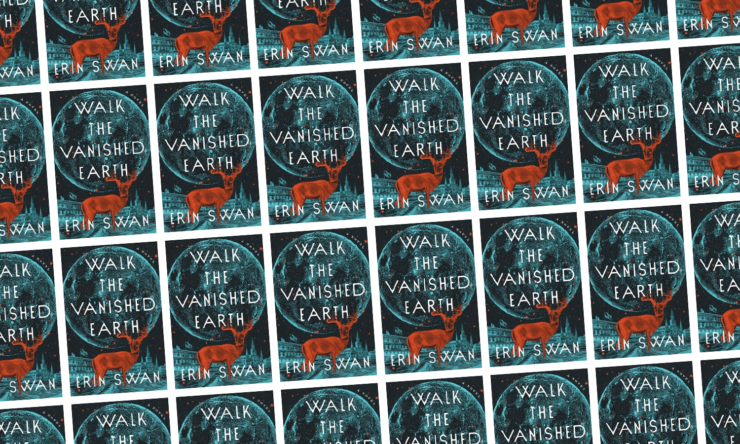There’s a certain strain of post-apocalyptic speculative fiction that gives off a curious prairiecore vibe. I don’t mean full-skirted dresses and basket weaving, but dreamlike journeys through a semi-rural American landscape that take subdued, earthtoned approaches to science fiction. Station Eleven is probably the best-known example of this trend that I literally just made up (full disclosure, I’ve only seen the show)—and at times, a little bit of Sweet Tooth and some of the Westworld HBO series.
This subgenre (I hesitate to use prairiepunk, which has apparently been claimed by a specific fandom—I’m hesitant to use “-punk” appellations at all) is filled with visually-driven explorations of our relationship with the natural environment on the cusp of revival. This is fertile ground for obsolete or hidden technologies that are romanticized and mythologized by various characters. There’s a feeling of movement, drifting, and even a bit of the surreal midwestern mood that Samuel R. Delany captured so freakishly well in Dhalgren—a literary oddity that lesser science fiction writers still aspire (and fail) to replicate. And as with life on the prairie, there’s also that central pillar of family—biological or otherwise—and the ways in which people cling to ideas of each other.
Walk the Vanished Earth follows the same paths with compelling, sometimes perplexing results.
Erin Swan’s debut novel tells the stories of a strange American dynasty stretched across two centuries: the 1870s, the 1930s, the 1970s, 1990s/2000s, and a far-off future on Mars where the final descendant of the dysfunctional Samson family becomes responsible for rekindling humankind. The Martian is Moon, a young human raised by her two strange Uncles on a planet of dust, until one day their nomadic little group arrives at an abandoned space station. It’s here that Moon finally begins to uncover her past, and figure out the beginnings of her future.
Buy the Book


Walk the Vanished Earth
For all its leaps back and forth through time, the story orbits around a very tight set of quasi-puritanical fixations: control over bodies (particularly women’s), lineage and heritage, and suppressed trauma. Early chapters with Bea—the ragged, selectively mute pregnant girl who harbors a giant in her belly—felt awkward and unsettling. At first blush it seems like a regressive deconstruction of brownness into wide-eyed, animal-like victimhood; Bea is a victim of abuse, and has largely retreated into her own head. Her inability to express herself to others leans on old tropes, albeit ones rooted in historical racism. Meeting adult Bea later in the novel—at this point she’s an avid painter and is capable of polite conversation—never really ameliorates the sense that she’s built on a foundation of tired stereotypes. Finally, Bea melts back into nature and becomes closer to a myth than a mother—a choice that remains prickly and weird in my head.
The Floating City is another choice that sits uncomfortably between a romanticized post-disaster New Orleans and Swan’s methodical portrayal of a ravaged, flooded planet. This is probably where the Station Eleven vibes are strongest—the idea of a bohemian survivalist community that’s grown out of the ruin, one that still celebrates and preserves art and history and humanity even knowing that more floods and more destruction will come. It’s a fleeting shelter, but one that knows its function as a refuge that maintains a sense of decency and wholesomeness in the face of chaos. Swan outs herself as an optimist, or at least someone with clear ideas of what they’d hope for in a future where everything is doomed to drown.
Despite my misgivings about certain narrative and stylistic choices, Walk the Vanished Earth is a book that I read easily, steadily, from beginning to end. Swan is particularly good at small, unassuming turns of phrase that employ the familiar fixed cadence and sense of economy that characterizes most of American creative nonfiction. There’s an almost formal literary quality to her style that occasionally flattens the ordered chaos taking place in this post-apocalyptic world. WTVE is ripe with highly refined snippets of dialogue, and one particularly effective exchange between Moon and a girl she finds inside a screen that showcases Swan’s flair for polish and control.
Like Station Eleven, WTVE is a contemporary exploration of cultural historiography that is usually downplayed in mainstream science fiction that prioritizes people and survival. It shines best when Swan is on the edge of introducing us to something new—when Paul is first toying with the idea of a disaster-proof utopia, or when Red Star sends a group of women into space for fertility experiments (at times, plumbing through the latter conjured a faint pang for Claire Denis’s brilliant film High Life, but that’s a story with a rather different message). The Red Star scenes are probably some of my favorites in the book.
But the book is also self-aware of the shortcomings of white narratives—for better or for worse, there’s a recurring thread of meta commentary about history, historiography, and mythology that often undercuts the power of Swan’s ambition (herself, a white American author) for the novel. For better or for worse, WTVE is very much a product of its creator in the way it approaches everything from gender to class and race (even the minor Southeast Asian character of Chantrea, particularly, felt a little careless) and at times I felt that it deliberately avoided prodding humanity’s uglier side for the sake of its overall message about self-determination and survival. The result is at times an uneven read, mostly in the earlier chapters, that are eventually eclipsed by Swan’s crisp prose, bold scope, and earnest vision for an uncertain new world.
Walked the Vanish Earth is published by Viking.
Alexis Ong is a freelance culture journalist with weak ankles who mainly writes about games, tech, and pop culture. Her work has appeared in The Verge, Polygon, Kotaku, Rock Paper Shotgun, VICE, Dazed Digital, and more; soft spots include science fiction, internet archaeology, comics, boxing, and old games. You can find her at her website or on Twitter.










